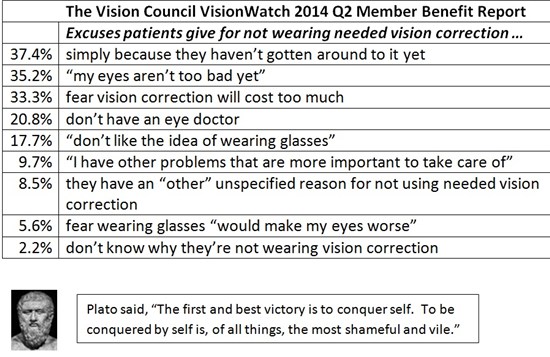 Many of your patients are procrastinators, say findings from The Vision Council VisionWatch 2014 Q2 Member Benefit Report. Some 37.4 percent of respondents say they aren’t wearing needed vision correction simply because they haven’t gotten around to it yet. Another 35.2 percent say they aren’t using needed vision correction because “my eyes aren’t too bad yet.” Some 33.3 percent say they fear vision correction will cost too much, and 20.8 percent say they aren’t using vision correction because they don’t have an eye doctor.
Many of your patients are procrastinators, say findings from The Vision Council VisionWatch 2014 Q2 Member Benefit Report. Some 37.4 percent of respondents say they aren’t wearing needed vision correction simply because they haven’t gotten around to it yet. Another 35.2 percent say they aren’t using needed vision correction because “my eyes aren’t too bad yet.” Some 33.3 percent say they fear vision correction will cost too much, and 20.8 percent say they aren’t using vision correction because they don’t have an eye doctor.
Another 17.7 percent say they “don’t like the idea of wearing glasses,” and 9.7 percent say “I have other problems that are more important to take care of,” while 8.5 percent say they have an “other” unspecified reason for not using needed vision correction, and 5.6 percent fear wearing glasses “would make my eyes worse.” Some 2.2 percent say they don’t know why they’re not wearing vision correction.
Do you make excuses for not doing what you know you need to do within the practice? Do you find yourself saying: “The task is too big to start right now,” “I need more time to study the problem” or “I don’t have a plan”? The list goes on and on.
The Vision Council VisionWatch 2014 Q2 Member Benefit Report shows our patients like to make excuses as well. The report tells us:

Here are the top five scientifically proven steps to claim that first and best victory of conquering self. These are the best lessons from psychological studies about how to defeat procrastination. Implement these five steps and take your practice to the next level.
1. Create a To-Do List.
The Zeigarnik Effect is a psychological phenomenon that has unfinished tasks stuck in your memory. It’s easy to find yourself wasting time thinking about unfinished business when that same time could be used to get things done. So, quiet the Zeigarnik Effect by creating a to-do list.
2. Write down a “why” for everything on your To-Do List.
This simple step helps provide the motivation to get it done. Visualize the completed project and how much better the practice is when the project is completed. Motivation drives the energy needed to get you moving.
3. Break big tasks into smaller parts.
Big tasks can be overwhelming. Break large, overwhelming tasks into smaller, manageable pieces. The smaller tasks are achievable and can start right now. Here’s a helpful insight to know when to do this … listen to the words you use to describe the task. If the words are scary, then break the task down into smaller pieces.
4. Forgive yourself.
Self flagellation is self defeating. Science says that you are more likely to move forward if you show yourself some compassion for your previous procrastination than if you beat yourself up. Take the positive road, draw a line in the sand, forgive yourself and move forward.
5. Doubt your doubts.
Two major obstacles that often hold people back are perfectionism and fear of failure. Science says to shake your head no when your inner monolog begins to entertain those negative thoughts. Doubt your doubts and move forward with the winning plan.























